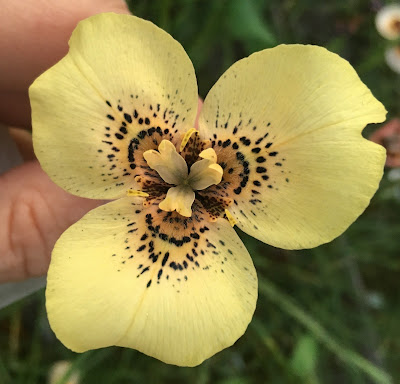Pollen parent: MM 14-86a (atropunctata x calcicola) X (villosa x tulbaghensis)
This is a nice cross that has several standout characteristics. First, the plants are vigorous and tall. Second, some of the offspring have extravagantly spotted flowers. Third, they all bloom several weeks later than most of the other hybrids, probably due to the late-blooming M. bellendenii in their ancestry.
Here's a family portrait:
MM 18-91e
Because many plants in this cross bloomed, I think we have some more evidence for several patterns I think I have been seeing in Moraea genetics:
-As I've seen before, having any M. bellendenii ancestry in a cross tends to deeply affect the eye of the flower. All of these flowers have either no eye at all, or a modified eye. So I think we can call that a dominant characteristic.
-Spotted patterns are not transmitted as strongly as the altered eye. About a third of these flowers have significant spots. Presumably the spots come from MM 10-02c, which was one of the parents of the pollen parent. There's also some M. atropunctata ancestry, which can transmit spots as well. But since we're seeing spots on a minority of the flowers, and neither of the parents were heavily spotted, I am thinking of that as a recessive trait.
-Despite having a bright yellow parent and a pinkish parent, these flowers are mostly orange. The yellow ones are a creamy yellow, not bright yellow. So I think it's safe to say that orange is a dominant characteristic.
-Finally, all of these plants bloomed at the same time, at the end of the blooming season. So perhaps late blooming is also a dominant characteristic.
I made a lot of crosses with these to see if I can get more color variety into this otherwise very promising family.












No comments:
Post a Comment
Due to spam, I am now requiring moderation for comments on most posts. I apologize if your comment does not appear immediately; I will approve it as soon as I can.